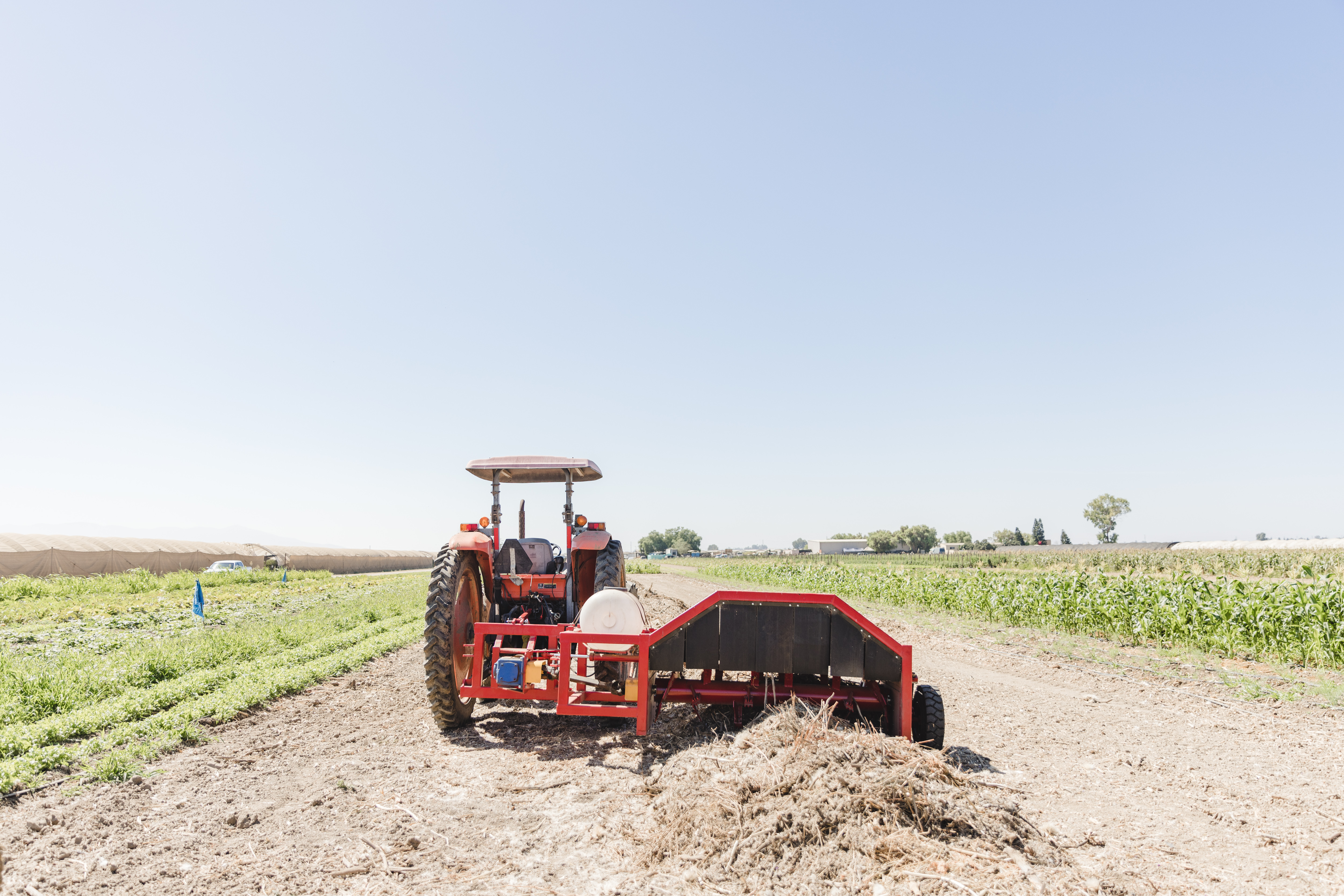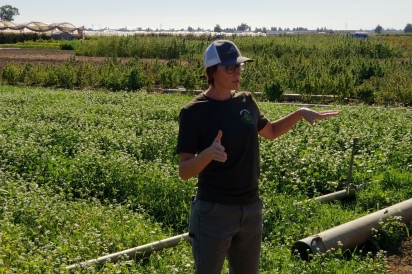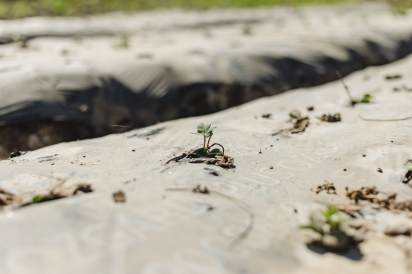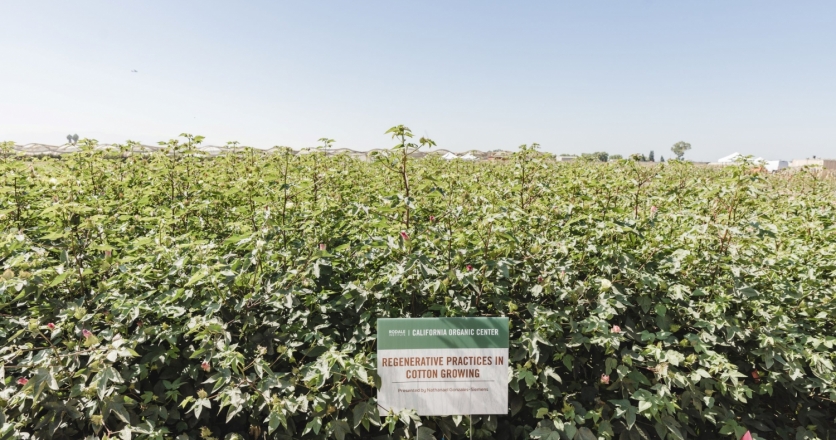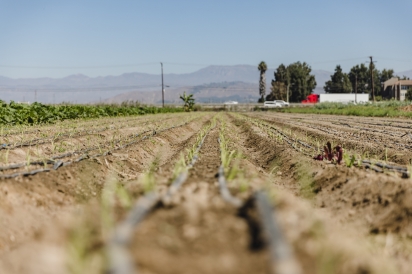Building a Better Cover Crop
When I arrive at the modest building housing the Rodale Institute California Organic Center at McGrath Family Farmers in Ventura, California, local farming legend Phil McGrath and his wife, Joanne, are playing ping-pong. We have barely introduced ourselves before the McGraths pivot the conversation to the subject of pickleball, imploring me to give the wildly popular sport—of which they are enthusiasts—a try.
Between ping-pong and pickleball, it’s easy to assume I’m in the presence of happily retired people who have given themselves over entirely to a life of leisure. And McGrath did retire from farming his own land in 2017, turning that task wholly over to a handful of small certified-organic farmers, including local CSA and farmers market staples like Baby Roots Farm. But it turns out Phil McGrath’s version of retirement is more active than many people’s version of full-time work, and, although he may enjoy a game of ping-pong while at the farm, he remains hard at work on his mission to promote regenerative agriculture.
One significant manifestation of this commitment to “a system of agriculture that continuously improves environmentally, socially [and] economically” was McGrath’s decision to partner with the Pennsylvania-based Rodale Institute in 2019 to establish its California outpost on McGrath Family Farmers’ land. In practice this means use of farm assets, including lots of old equipment; rental of office space and five acres for experimentation and innovation; and, perhaps most critically, mentorship from McGrath for the small onsite Rodale team. Rodale brings the technology and knowledge from its 75-year history of organic, regenerative farming to help solve agricultural challenges that are more prevalent in California, including drought and wildfires, as well as pesticide use that remains at an all-time high despite California’s domestic leadership in organic farming.
While I would happily talk to McGrath all day, I’ve come to the farm to meet a key member of the local Rodale team, Research Director Arianna Bozzolo, who, with the help of Farm Manager Tony de Veyra, is responsible for much of the innovation work being done onsite. Bozzolo grew up in Bergamo near Milan, Italy, earning her bachelor’s, master’s and doctorate degrees in horticulture, entomology and viticulture respectively from the University of Padua, which she charmingly points out is “close to Venice, area of prosecco, sparkling wine.”
A requirement for her PhD program was to work abroad, which she satisfied by studying compost at the University of Arkansas. After graduation, she returned there to work as a technician, moving through several more U.S.–based posts in both academia and private sector work related to viticulture before realizing that “making wine might not be the scope of my life.”
When Bozzolo saw the opening for the research director position at the Rodale Institute California Organic Center, she jumped at the chance. The pandemic dictated that her interview was done over Zoom, and upon being hired, she was told to “go to this address that day and do meaningful research.” Bozzolo was undaunted by the open-ended nature of what she had undertaken. Guided by Rodale’s mission of soil health, she got to work. “You want to do something good in your life, and Rodale gave me that chance.”
Under the auspices of two United States Department of Agriculture (USDA) and California Department of Food and Agriculture (CDFA) specialty crop grants, a Healthy Soils Program CDFA grant and donations from organizations including Patagonia, Oxo and Patel Foundation, this currently looks like a series of experiments using cover crop instead of plastic mulch with the aim of creating a more sustainable way to grow. Rodale pioneered a system of no-till farming: growing cover crop, terminating it with a roller crimper—a piece of heavy equipment—and effectively growing your own mulch in the process.
“About 37% of U.S. farm acreage uses no-till farming, with strong adoption rates in the Northeast, the Mid-Atlantic states and the Midwest,” says Bozzolo. In the eastern United States, this is widely used for corn and soyabeans, but Bozzolo is trying this with crops that are more common in our region, starting with strawberries.
This is a challenge, both because strawberries are grown on raised beds, which makes using the roller crimper more difficult, and they’re delicate. But the theory is if it can work for strawberries, it can work for other crops.
For cover crop, Bozzolo is using sorghum. So far, an irrigation leak and the region’s marine layer have kept the sorghum from dying off completely. And unlike in the eastern part of the U.S., she can’t rely on frost to do the job for her. Still, Bozzolo is undeterred, and is experimenting with alternatives like undercutting and roller crimping the sorghum twice. She knows the cover crop method is practiced successfully for non-organic farmers using herbicide, and she’s resolved to find a way without it. “Cover crops plus herbicide [method] is more common in the eastern U.S. In our region (coastal), where we can produce cash crops all year long, the use of cover crops is not as common. However, with the megadrought we are experiencing, cover crops should be taken in consideration because [using them] can increase soil resilience.”
She’s also cheered by McGrath’s conviction, given his lifetime of experience in farming. “He was the first one who saw the roller crimper and said, ‘yes, this can work,’” she says.
It’s time for a tour of Rodale’s five acres of experimentation, and we are reluctantly joined by Bozzolo’s fluffy gray dog, Papu, who’s named for the Argentinian footballer Papu Gómez who once played for her hometown club. Bozzolo adopted him during the height of the pandemic, and McGrath agreed to let Papu accompany her to the farm with high hopes he would catch squirrels. His career as a field dog was less exalted than his namesake, scuppered by a squirrel that bit him in the tail in his first week on the farm.
With Papu finally coaxed into joining us on our walk, we start at a control patch of strawberries that are farmed with conventional plastic mulch, designed to keep the weeds down. Bozzolo points out there are still weeds. “What I want you to notice is it’s not a magic bullet. You need to weed anyway.”
Farther along we reach her current cover crop experiment with strawberries, where she points out the variable states of unplanned survival of the sorghum. She’s interested in experimenting more with how the strawberries were transplanted, working the soil more or changing the amount of water. Another system she’s trying is intercropping with clover, which is a legume so it can “fix” nitrogen from the air to provide nutrients to the strawberries—something plastic decidedly cannot do.
Her job, she tells me, is “to try something that the growers cannot afford or don’t have the time or the money or don’t want to. I can do all the mistakes they cannot do until I’ve found the system.”
Next, she points out a spot where she will soon start a pumpkin project with oats and peas as cover crop. Pumpkins are a strong plant with big seeds and big fruit, and she’s confident she’ll see better results than with more delicate strawberries. She’s also excited about trying peas as a cover crop because they’re edible.
“The growers don’t want to grow cover crop because it’s a waste of time and land. But I noticed here growers grow peas and sell tendrils at the farmers’ market. At least it’s an income the growers can have while they’re growing cover crop.”
Bozzolo is keenly aware that adoption of the techniques she’s piloting depends on their financial viability, and each of her projects includes an economic analysis at the end.
Another experiment had economics front and center, aiming to help an Italian textile company create a closed-loop economy for its denim production. The trial is using the fluffy cotton byproduct of that production in soil growing cotton—which in its untopped state looks like hibiscus to my untrained eye—to determine if it helps the cotton plant retain moisture.
Findings so far indicate the byproduct material degrades in 12 weeks, so Bozzolo does not expect to see any impact given cotton has a longer growing cycle. However, she speculates that with tomatoes or peppers, which have a shorter growing cycle, she may be able to demonstrate a difference in growth or amount of fruit. It’s not the closed-loop economy the textile company was hoping for, but such is the path of much innovation: Benefits often accrue outside the originally intended use.
Speaking of peppers, Bozzolo points out the spot where she is planning an experiment with them alongside zucchini and eggplant. The three crops have been selected because they have different growing cycles: short, medium and long. This will allow her to measure how long she can make the cover crop mulch last across the different growing cycles.
Intercropping, the practice of cultivating two or more crops in a field simultaneously, has advantages, including water use efficiency and the potential for the benefits of companion planting, such as when two vegetables grown in proximity can help repel pests. However, Bozzolo also explains that mechanical harvesting presents a challenge to operationalizing intercropping with crops that have growing cycles of different length. It’s hard for a machine to harvest well at the level of detail needed for the varied plant growth.
And machinery is an important part of the overall equation in all Bozzolo’s experiments. If, for example, a farmer can no longer use their expensive piece of machinery that has historically been used for putting down plastic mulch, can they use it for something else? These are all questions Bozzolo knows she needs to answer. She realizes she’s dealing with the challenge of how to drive behavioral change, not just scientific experiments.
Back on our tour, we come to the pièce de résistance of Rodale machinery: the roller crimper used to kill the organic cover crop. It’s made of dusty red metal with a signature chevron design to the roller, and it was the first piece of equipment Rodale sent Bozzolo, even before she had a tractor to pull it. (McGrath has since provided a 1980s model tractor, and they have applied for a grant that will help them buy an electric tractor, which McGrath believes will be the first in use in Ventura County.) Bozzolo got the message inherent in the roller crimper’s arrival. She recounts with a laugh her realization at the time: “I guess this is my research.”
And it did take some research to figure out how to best put the roller crimper into service. They worked out some details by trial and error, learning about parameters like wind direction and whether you always need to crimp on the same side (you do). Despite the difficulties, throughout our conversation Bozzolo remains resolute, not just about the roller crimper, but about all her experiments with regenerative agriculture.
“I believe it can work. We just need to nail down the details. And to do that, we need just to try.”
So far Bozzolo has focused on the innovation work she is doing with Rodale and McGrath, paying close attention to how this can be operationalized at scale by farmers. But before I go, I ask for her thoughts on the role of consumers in this ecosystem.
Bozzolo tells me about Regenerative Organic Certified (ROC), a certification program that builds on the USDA Organic certification and existing animal welfare and social fairness standards bodies. First piloted in 2017 with participation from the Rodale Institute on the Soil Health Advisory Committee, a handful of early adopters have since earned the ROC designation. These include Ventura County companies like Patagonia, for its Regenerative Organic Chile Mango from its Patagonia Provisions line (made in Sol Simple, Masaya, Nicaragua), as well as Moorpark’s Apricot Lane Farms’ avocado oil.
Bozzolo is hopeful that in the future this certification will help consumers more easily identify and purchase organic, regeneratively farmed goods. However, she acknowledges the reality that there is not yet a critical mass of ROC products available in supermarkets. In its absence, Bozzolo urges people to eat certified organic.
“It’s good for us to eat organic for the environment, but sometimes you don’t have to do things for the environment. Just do it for yourself or for people who you love.”


